Contents
The primary way to open the Run Configuration or Debug Configurations dialogs for a StreamBase application is:
-
In the Project Explorer view, right-click the name of the StreamBase application of interest. From the context menu, select > (or >)
You can also use one of the following alternative methods:
-
Select from the dropdown arrow next to the (
 ) button in the Studio toolbar (or next to the (
) button in the Studio toolbar (or next to the ( ) button).
) button).
-
Right-click in the EventFlow Editor canvas for your application. From the context menu, select >.
-
In the Project Explorer, right-click the name of your application's StreamBase application. From the context menu, select >.
Run configurations are stored as metadata in your Studio workspace. Thus, although your set of named Run Configurations is common to all your StreamBase projects, an individual Run Configuration includes the path to the individual module, project or application, so you cannot share Run Configurations between StreamBase or LiveView projects.
The top row of each run configuration dialog contains the Name field, common to all tabs:
- Name
-
A configuration name is generated for you when you first run a StreamBase application. You can change the name according to your site's standards. The name you enter is not reflected in the navigator pane on the left until you click Apply.
Studio automatically creates a new Run Configuration for you the first time you run or debug a module, with the configuration taking the name of the top-level module being run. These Run Configurations are created with default settings, and you can edit or copy them to specify custom settings.
You can also create a new Run Configuration from scratch. To do this, open the Run Configurations or Debug Configurations dialog and do one of the following:
-
In the left pane, right-click StreamBase Application and choose New in the context menu.
-
In the left pane, select StreamBase Application and click the New toolbar button.

-
Select the name of an existing Run Configuration and click the Duplicate toolbar button.
A named Run Configuration does not exist for the StreamBase application until you have run the application at least once.
To edit an existing Run Configuration:
-
Open the Run Configurations or Debug Configurations dialog.
-
Select the name of the configuration to edit.
-
Make changes in the tabs of the wizard and click the Apply button before you leave each tab.
-
Click to undo changes since the last saved version.
Note
The Run Configurations or Debug Configurations dialogs restart showing the last configuration you opened. This is not necessarily the configuration for the StreamBase application whose name was active when you invoked the Configurations dialog.
After applying your edits, you can:
-
Click to preserve your edits and exit the dialog.
-
In the Run Configurations dialog, click to run the edited Run Configuration.
-
In the Debug Configurations dialog, click to run and debug the edited Run Configuration.
The Main tab of a StreamBase application Run Configuration configures the primary settings for running this application in Studio.
 |
- StreamBase Application Archive (.zip)
-
Specify the path to the application archive file to be run or debugged, using the button. The resulting dialog shows the folder path to all StreamBase applications in your Studio workspace. Select the archive of interest and click OK.
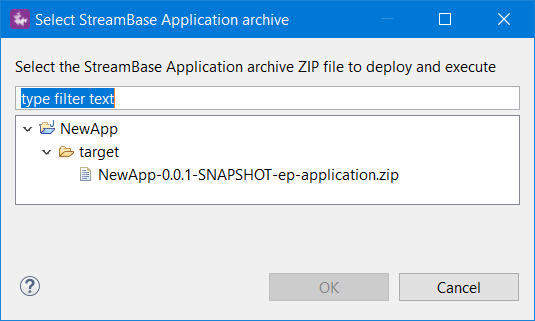
- Node Deploy Configuration File
-
Specify which configuration files to use in the next run or debug launch of this StreamBase application, using the button. If your application contains more than one configuration file of the same HOCON type, specify only one per type. For example, if your application experimentally contains two configuration files of type
sbengine, the launch halts with a runtime error. Select which configuration file to use for the next launch from Studio.
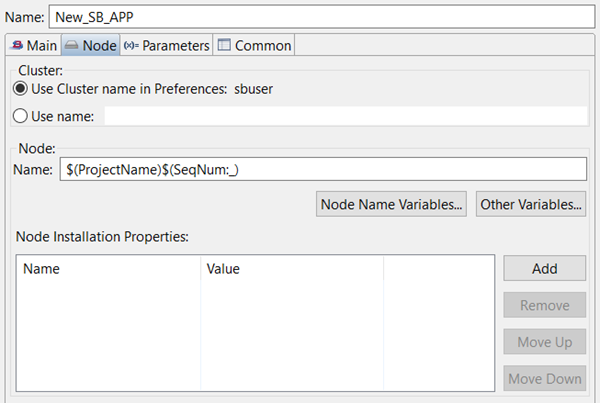 |
- Cluster
-
The default cluster name for Studio-initiated nodes is the system login name in effect when Studio started, and is not specified in a Run Configuration. You can change the default cluster name in Studio Preferences.
Alternatively, you can specify a cluster name on a per-run configuration basis in the Use name field.
- Node Name
-
This field specifies a name for the node that Studio creates to contain this StreamBase application. For example, you can specify here the same node name you are using in your test and deployment environment with the epadmin command.
Studio's default node name is generated from a naming pattern generated from a set of variables. Use the button to select a different set of project-related variables, or use the button to specify variables available to Studio as a whole. The naming pattern you assign must include the
S(SeqNum)variable, to make sure that a sequence number is assigned to make node names unique. - Node Installation Properties
-
Use this control to specify one or more parameters for Studio to use when it installs a node to contain this StreamBase application. The valid parameters are the same as can be used with the epadmin install node command; run
epadmin help nodeat the command prompt to see the available parameters.The feature is best used with parameters such as memorysize to specify a JVM heap size larger than the default 512 MB for certain EventFlow or LiveView fragments.
Note
Do not specify parameters that are already specified in this Run Configuration or elsewhere in Studio.
For example:
-
Do not use the nodename parameter to name the node, which is already accomplished above.
-
Do not use the producthome parameter to override the location of the current StreamBase installation from which Studio is running.
-
Do not use the substitutions or substitutionsfile parameters. Specify those instead on the Parameters tab for this Run Configuration.
In addition, do not use parameters that change the default adminport, adminhost, discoveryport, or discoveryhost, or this node may fail to appear in Studio's Clusters view or with the epadmin display services command.
-
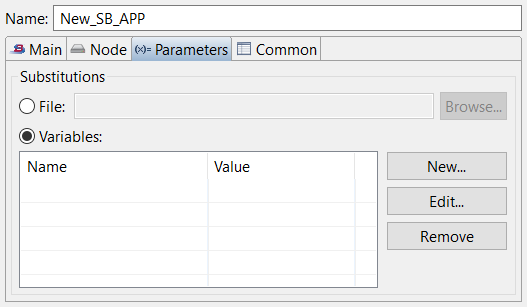 |
- Substitutions
-
Use this field to define substitution variables, or to specify a file that contains substitution variables. See Substitution Variables for more information on using substitution variables in configuration files.
Take, for example, a security configuration file that includes the property
portNumber = ${LDAP_PORT}. If you include a Name-Value pair in the Substitutions table, where the name isLDAP_PORTand the value is a non-default port such as 5389, then when the project is run and the configuration file is read, theportNumber =line in that security configuration file is read as if the file contains:portNumber = 5389.
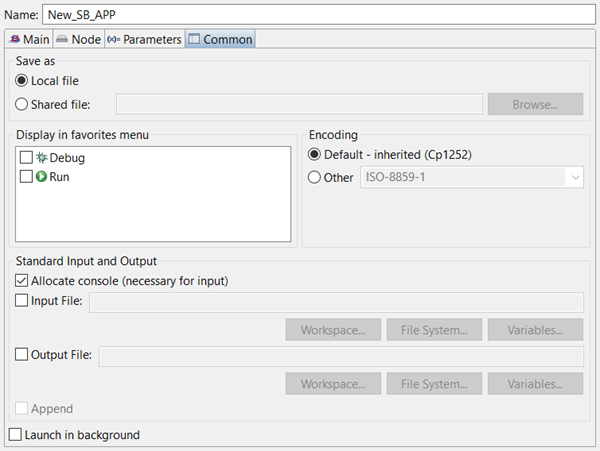 |
The settings in the Common tab are common to all Eclipse Run Configurations. Use Eclipse Help to learn how more about these options.
- Save as
-
This option determines where this Run Configuration is saved. The default setting, Local file, saves configurations in the workspace metadata area. As an alternative, you can select Shared file to save this Run Configuration as a file in one of your project folders. In this case, the Run Configuration is saved as
Name.launchNameis specified in the Name field. Specify the target project folder using the button. - Display in favorites menu
-
The favorites menu is a list of Run Configuration names that appears in the second section of the dropdown menu of the and buttons on the toolbar. The first section contains a changing list of recently Run Configurations. Add a configuration to the favorites section to keep it in the menu, even when other applications have replaced it in the recently-run section. This option performs the same function as the Organize Favorites option in the and drop-down menus.
- Encoding
-
Use this section to specify a non-default character encoding for log messages sent to the Console View (and optionally to a standard output file).
- Standard Input and Output
-
Allocate Console is selected by default. This specifies using the Console view to display logging messages written to standard output and standard error.
Input File is not supported by StreamBase application launches.
Output File is unselected by default. To specify that standard output and standard error of your application's run are written to a log file, select the Output File check box, and enter a path to a file. If the specified file does not exist, it is created for you. If both Allocate Console and Output File options are selected, log messages are written to both places.
You must designate the path to the file using Eclipse-specific syntax. Rather than typing a path, use the or buttons to navigate to a workspace or file system folder, and specify a file name. These buttons let Eclipse write the syntax for you. If you are familiar with the Eclipse syntax required in this field, you can use the button to build up a path from components.
is dimmed unless the option is selected. Select the checkbox to have log messages appended to the file specified in the Output field. If unselected (the default setting), the designated file is overwritten with each run of this configuration.
- Launch in background
-
Use this option to specify that the launching process itself runs in the background. (The StreamBase server that hosts your StreamBase application is always run in the background.) Selecting this box returns control to Studio immediately when you launch this configuration, without displaying the usual Starting Server dialogs.
By default, running or debugging a StreamBase module with a Run Configuration automatically switches StreamBase Studio to the SB Test/Debug perspective, after prompting you to confirm. You can specify on the prompt dialog to not ask again.
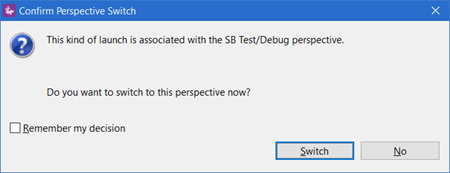 |
The option to switch perspectives is not stored in the Run Configuration itself, but is a global setting for all StreamBase applications, specified in Studio Preference Settings.
